#The American Experience
Text
"Nazi Town, USA" is a 2024 feature in PBS's American Experience series. It looks into the surprising degree of influence which Nazis had in the United States in the 1930s. There were even Nazi summer camps for kids.
It can be viewed (probably for a limited amount of time) at the series link above. Here's a preview...
youtube
To explore the topic more deeply, check out Rachel Maddow's excellent 8-episode podcast Ultra.
Rachel Maddow Presents: Ultra | an MSNBC original podcast
Ultra has somewhat more emphasis on Nazi attempts to penetrate government.
Those espousing Nazi-friendly views in the 1930s did not disappear when the US entered World War II and fascism became very unfashionable. Those half-hidden feelings hibernated and occasionally emerged from time to time to poison discourse and endanger democracy. There are obvious echos of that movement today.
#nazis#nazi town usa#german-american bund#the american experience#pbs#1930s#us history#fascism#the great depression#rachel maddow#ultra#donald trump#maga#election 2024#freedom vs. dictatorship
95 notes
·
View notes
Text
small town rural life is so insane, the dichotomy between "truly wholesome" and "genuinely batshit" in two real life examples:
My town has a legitimate spiderman: a random dude who dresses up in a spiderman costume, hangs out downtown, and helps people. Nobody knows who he is, he's not on anybody's payroll, he just literally hangs out and tries to do random acts of kindness, find lost dogs, point lost people to the best taco spot...
recently, the main bar in my town had an incident where a guy sat on his friend's lap, causing the loaded, un-safety'd gun in his pocket to go off, shooting directly into said friend's dick and balls (everyone lived but oh my god) Now, my friends and I can go to the bar and choose whether or not we'd like to sit in the spot where that one guy got his dick shot off.
I feel like these two stories perfectly encapsulate both sides of this experience.
19 notes
·
View notes
Text
The Bombshell Political Report So Shocking A U.S. President Tried To Pretend It Didn't Exist! LBJ Tried To Torpedo The Official Kerner Commission Record. Instead It Became A Bestseller
— May 10, 2024 | Jelani Cobb
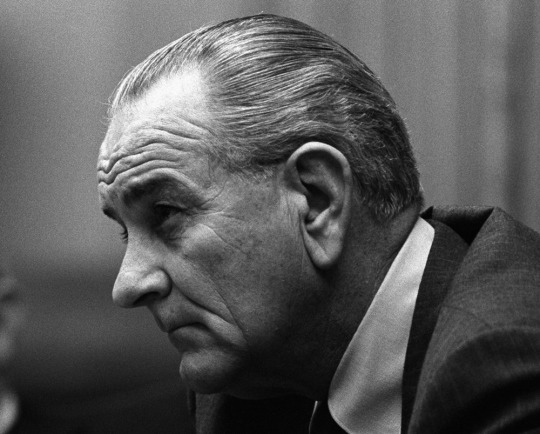
President Lyndon Baines Johnson listens during a meeting in the White House Cabinet Room, March 26, 1968. LBJ Presidential Library.
When President Lyndon Baines Johnson created the [Kerner] commission in July 1967 it was tasked with understanding what had happened up to that moment. Nearly two dozen uprisings or, in the antiseptic language of the report, “civil disorders,” had occurred between 1964 and 1967, with the largest and most destructive taking place in the Watts neighborhood in Los Angeles over the course of five days in August 1965.
Kerner has endured not simply for its prescience but also for the breadth of its analysis of the moment when it was conceived. The National Advisory Commission on Civil Disorders, which became more commonly known as the Kerner Commission—a reference to then-governor of Illinois Otto Kerner, who served as its chairman—was created by President Lyndon B. Johnson’s Executive Order 11365 on July 28, 1967. The order was issued as entire stretches of the city of Detroit lay smoldering.
On July 23, 1967, a police raid on an after-hours bar in Detroit sparked an explosion in which residents hurled rocks and bottles at police and culminated in a nearly week-long uprising marked by arson, looting, and forty-three deaths. Just eleven days earlier, the city of Newark had detonated following the assault on John Smith, a Black cab driver, by white police officers. The reactions in the community were immediate and incendiary. In the chaos of social retribution that ensued, twenty-six people were killed and hundreds more injured, while the city sustained an estimated ten million dollars in damage.
Newark and Detroit were just the most notable of more than two dozen American cities that ignited in revolts in that summer of 1967. It appeared as though a valve of the city reservoir had been opened. An apocalyptic fury, the response to decades of discriminatory policy and centuries of racial exploitation, suddenly spewed out in American cities.
Johnson charged the eleven-member Kerner panel with answering three questions: “What happened? Why did it happen? What can be done to prevent it from happening again and again?” These were Johnson’s precise words. Addressing these questions, however, would mean answering dozens of subsidiary questions the roots of which lay deeply tangled in American history and public policy.
The members themselves represented a cross section, albeit not a representative one, of domestic interests. Chaired by Kerner, the second-term Democratic governor of Illinois, the commission included two of his fellow Democratic elected officials, Congressman James Corman, the fourth-term representative of California’s twenty-second district, and freshman senator Fred R. Harris of Oklahoma. They were joined by three Republicans, New York City mayor John V. Lindsay, Rep. William M. McCulloch of Ohio’s fourth district, and Edward Brooke, the freshman Massachusetts lawmaker and the sole African American serving in the United States Senate at the time.
By current standards the commission was overwhelmingly white (nine of the eleven members) and male (ten of eleven). Katherine Peden, the commerce secretary of Kentucky, was the sole female commission member. Roy Wilkins, the political moderate and executive director of the NAACP, joined Brooke as the only Black people at the table. In addition, I. W. Abel, president of the United Steelworkers of America, represented labor in the proceedings, and Herbert Jenkins, the police chief of Atlanta, Georgia, represented law enforcement. Charles Thornton, the CEO of Litton Industries, spoke for the manufacturing sector.
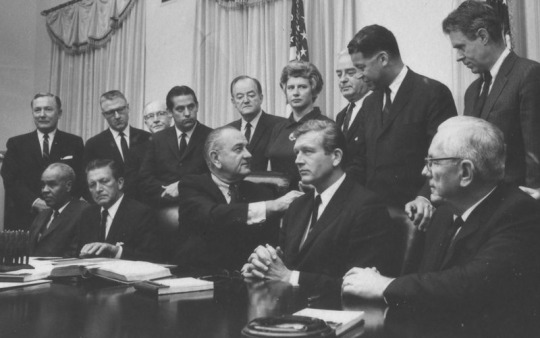
President Lyndon Johnson (seated, center) shakes hands with members of the Kerner Commission. July 29, 1967. White House Photo Office Collection, LBJ Presidential Library.
What differentiated the Kerner Commission from the outset was the historical scope of the investigations: the members were not seeking to understand a singular incident of disorder, but the phenomenon of rioting itself. Despite the heterogeneity of interests, if not the bipartisan backgrounds, of the members, the concluding report spoke with a strikingly unified voice about the problems that the various committee participants sought to understand. And that voice was an unabashedly integrationist one. Their most immediate and salient observation was that, even though the police had been involved in these most volatile incidents, American cities were not simply facing a crisis of policing. Rather, police were simply the spear’s tip of much broader systemic and institutional failures.
[T]he Kerner Report noted that the “problem” had been, first and foremost, inaccurately diagnosed. The so-called Negro problem was, in fact, a white problem. Or, as the report noted in one of the oft-quoted sections of the summary, “What white Americans have never fully understood—but what the Negro can never forget—is that white society is deeply implicated in the ghetto. White institutions created it, white institutions maintain it, and white society condones it.”
In a best-case scenario, Kerner would have become a kind of guidebook for the War on Poverty policies then being enacted by the Johnson administration. In more practical terms, the commission recommended new community-based guidelines covering how police needed to interact with citizens of “the ghetto,” as Black communities were dubiously classified in the report. It devoted an entire chapter to the ways in which justice should be administered in the course of riots; it suggested a national network of neighborhood task forces, local institutions that could bypass the bureaucracy and red tape of city administration and head off problems before they erupted into crises. It suggested “neighborhood service centers” to connect residents of these communities with job placement and other forms of assistance and proposed expanded municipal employment as a means of diminishing chronically high unemployment in these areas.
Perceptively, its members suggested that the monochromatically white news media that reported on these uprisings was also a symptom of the bigger problem. That social upheaval that had been created by overwhelmingly white institutions and maintained by said white institutions was then investigated and reported upon by yet another overwhelmingly white institution constituted, in their assessment, a racial conflict of interest. They closed with a raft of specific recommendations for housing, employment, welfare, and education. Kerner was possibly a victim of its own meticulousness. The report brims with suggestions. One reason why its proposals were not realized might be that it simply made too many of them.
The commission could not have known when it released its findings in March 1968 that it was issuing a preface, not a postscript. Martin Luther King Jr. was assassinated the following month, and more than one hundred American cities exploded into just the type of violence that the Kerner Commission had sought to understand if not prevent. [T]he Report was fated, from the moment it reached shelves, to operate more crucially as a forecast than a review. “Our Nation,” it warned in 1968, “is moving toward two societies, one black, one white—separate and unequal.”
— Excerpted From "Introduction" By Jelani Cobb, From The Essential Kerner Commission Report, Edited By Jelani Cobb, With Matthew Guariglia.
#Article#The American Experience#PBS | NOVA#President Lyndon Baines Johnson#The Essential Kerner Commission Report
3 notes
·
View notes
Text
Me reading about how goldfish crackers potentially have exposure to cancer-causing chemicals while simultaneously shoving goldfish into my mouth: huh. Interesting
3 notes
·
View notes
Text
i'm conducting an experiment. everyone who's from an english speaking country state your country, regional area and what you call the following images. i need to see something







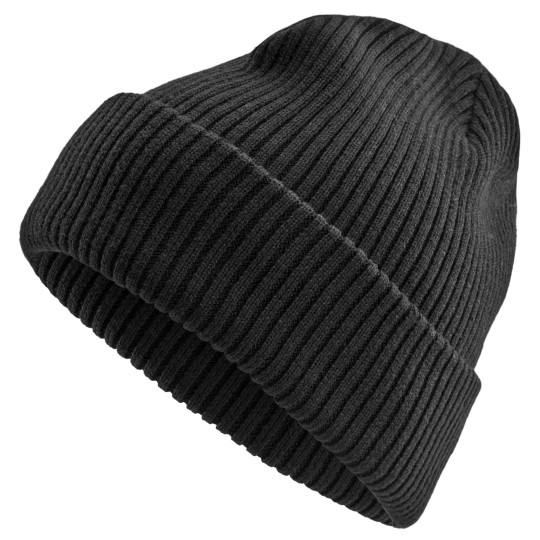

#ex: united states > south > sodapop#please rb so more people see#american english#australian english#british english#canadian english#english#english language#dialects#accents#american accent#australian accent#british accent#canadian accent#english accent#america#australia#england#canada#those four are my target audience but all answers from around the world are welcome!!#tumblr#discourse#experiment
28K notes
·
View notes
Text
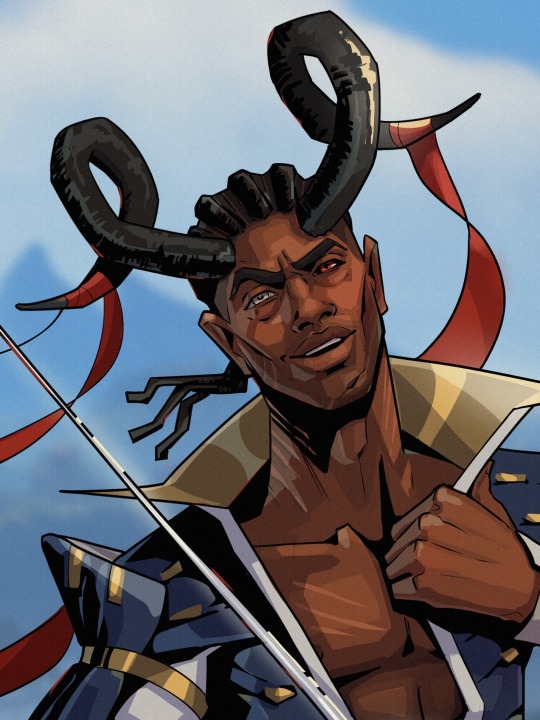
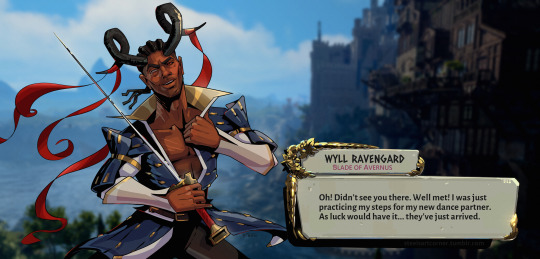
nobody took my pen away so the hades-crossover-fever continues. i’m ill
others: the dark urge (OC); minthara (bg3), karlach (bg3), shadowheart (bg3), gale (bg3), halsin (bg3), lae'zel (bg3), astarion (bg3), kotallo (horizon)
#wyll ravengard#Wyll#bg3 wyll#wyll bg3#hades supergiant#I think I went too detailed on the lighting for the hades style but it’s ok. he deserves a treat#american comic book/hades style wyll it is#I’m experimenting what can I say#bg3#bg3 fanart#my art#it’s wyll Wednesday everybody#hades game#hades series
12K notes
·
View notes
Text
Guys, I need to know something (if you're american)
#been realizing that this might not be a universal american experience#tumblr polls#polls#random polls#9/11#9/11 mention
11K notes
·
View notes
Text
Clark grows up on Amity
So! When Clark's shup landed on the Kent Farm, it unfortunately started a bit of a Fire. It was pretty bad, and by the time it was put out most of their Crops had been burned up.
Using their Savings, the money from the remaining Crops, and some goodwill from their neighbors, the Kent's managed to get enough money together to move to a new Town to start over. It also helped that in a new town nobody would question them suddenly having a Baby despite Martha not being Pregnant.
They Move to a small farm on the Edge of Amity Park.
Clark Kent grows up in Amity Park, goes to Casper High, and befriends Danny, Sam, and Tucker as his childhood friends.
When his powers come in, they are the first ones to know. When Danny has his Accident, Clark is there to help him control his new abilities. When Clark has to move away for his new Job in Metropolis, they are all there to wish him good luck and throw him a Going Away Party.
As Superman, Clark is more open to joining a Team since he used to be on Team Phantom.
When Justice League Dark is formed, Superman is a Suprise Member, since he actually had a lot of experience with the Supernatural.
When Kon is born, he turns to his best friends for help and advice on his to deal with the situation. Danny had Ellie in very similar circumstances, so he is more open to the idea of adopting Kon since he has personal experience with Clones made by Madmen.
Thoughts?
#Dpxdc#Dp x dc#Dcxdp#Dc x dp#Danny Phantom#Dc#Dcu#Clark Kent grows up in Amity Park#The Kent's move to Amity Park#Clark and Danny are childhood friends#I find it really funny that Superman is on JLD because he has more experience with the Supernatural than half the team#They really didn't expect it from All American Boy Scout Superman#Until the day they come across a Ghost who sees Superman and SHRIEKS because “that's the Ghost King's personal advisor!!!”#Excuse me. Whomst!?#Constantine is considering selling his Soul to Superman#Shazam is wondering why Zeus (Vortex) is screaming profanities about the Ghost King in his head#Wonder Woman wonders if Superman has met her Aunt Pandora#Chaos all around
2K notes
·
View notes
Text

#self care#american psycho#christian bale#female experience#female hysteria#female insanity#female manipulator#female rage#gaslight gatekeep girlboss#gaslight gatekeep girlblog#girl blog#girl blogging#girl blogger#girl boss gaslight gatekeep#girlblog#girlblog aesthetic#girlblogger#this is a girlblog
3K notes
·
View notes
Text
Bonus round! Do you use a queue tag?
#ive been super curious about this because people seem to have really strong opinions on the queue! so many people seem to HATE it#but i love using the queue! i dont really know exactly why i like it so much- i started using in like... 2016 and its a fundamental part of#my tumblr experience now. i think i started off just using it for offline hours so id hit most my american mutuals (/ for aes posts)#but these days basically everything goes in my queue (cept time sensitive things & like. current hype and original posts-#anything 'normal' posting is in the queue)#idk it feels. nice to me! i like to spread out my posting and not rb 30 things in half an hour and then disappear for the rest of the day#esp since my spaces are so circular- the same post runs on my dash a dozen times minimum. and i get to put it on ur dash a week late!!!#and its so nice to have small interactions with mutuals in incompatible timezones; to open up my notifications in the morning#and go: oh! my friends were here <3#its such a Part of the tumblr experience for me i dont think i could ever truly change now. maybe switch to timed queueing#but my availability changes so much i prefer to just. know i guess#but (i am so sorry for all that) im curious about how other people feel!!!!!! itd be so interesting to hear abt why people do/do not like i#i know some people like the experience of spamming and going. some people think it makes this seem to much like influencing or whatever#everyone has their reasons and i want to know!!!!!!!!!!!!!!#nyxtalks#poll#queue#no see answers option because you must fall into one of these
1K notes
·
View notes
Text
me when i get creepy men in my DMs:
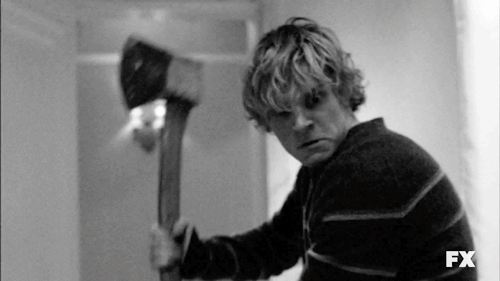
#evan peters#american horror story#just girly thoughts#girl interupted syndrome#girlblogger#lana del rey#this is a girlblog#girlblogging#just girly things#coquette#dollette#lana del ray aesthetic#lana del ray aka lizzy grant#lily rose depp#mazzy star#girl interrupted#this is what makes us girls#femcel#the female experience#pearl 2022#black swan#tate langdon#hell is a teenage girl#tumblr girls#girlhood#female manipulator#manic pixie dream girl#gaslight gatekeep girlboss#girlrotting#ahs
1K notes
·
View notes
Text
best part of fantasy high has to be that brennan lee mulligan famously
a. did not attend high school
b. is not from a suburb
#those are probably the two most universal american experiences#and he somehow avoided them both#home schooled nyc kid playing a jock .. incredible to think about#dimension 20#fantasy high#brennan lee mulligan
2K notes
·
View notes
Text








happy pride to all queer children of immigrants
patreon
#muertodraws#queer art#queer comic#lgbtq#pride#trans artist#qtpoc#trans art#transgender#transmasc#mlm#if youre a queer child of immigrants you deserve free lifelong therapy#this comic was originally going to be a “i feel like a freak” cuz im trans and people dont know what to do with me#and then it turned into like. oh god this experience is compounded by your complicted relationship to uhh well#being mexican and a child of immigrants#i was originally going to add a quote from a jose marti poem but idk i didnt want this to get too long#i think if i did that i would prolly attract the attention of latine purists and nationalists lmfaooo#i already have people who dont even believe im mexican much less a child of immigrants much less a man#the most common hate i get now is that im a confused white woman gringa who isnt latin american#besides the transphobia im just like. have you ever heard of a diaspora#anyway#hope someone enjoys this
959 notes
·
View notes
Text
Funny things about being in jewish culture™
You absolutely cannot expect jews to (1) stay on a topic topic or (2) be concise. The notion of "having a topic" to talk about is merely a suggestion (apparently, this includes me)
Jewish time means you're transported into a universe where time doesn't exist. Every shul has to have a portal to a different plane of oblivion - it's as important as having the scrolls in the ark
You might only know someone by their hebrew name and consider if they will look at you weird if you call them by it outside of shul
There is a latent jewish mother hiding in everyone and that mother will arise like a sleeper agent if someone has deduced that you aren't eating enough during any potential communal meals
Why so many puns
Why are all of you as sarcastic as me...
The one person who's actually fluent in hebrew flexing their superior language comprehension (diaspora)
Celebrating having a minyan
Singing prayers to popular children's songs
It's surprisingly normal to ask about someone's bris if it comes up
There are seven people in the building, yet I thought there were twenty
#jumblr#jew by choice#jewish conversion#personal thoughts tag#meme#yes this post is made with the acknowledgement that all cultures have similarities#and that Jewish Culture™ is not ultimately unique compared to other cultures#i was raised in american protestant culture which - in my experience - is VASTLY different than my community now#you know how SHOCKED i was when my rabbi was like 'so my daughter said i was a communist when we discuss politics!'#apparently my brain thinks we wiped out the commies during the red scare (sarcasm)
713 notes
·
View notes
Text
truly fucked that eye contact is seen as a threat or challenge to most animals but people have decided that it's polite and you HAVE to do it. Get real
edit: turning off reblogs because too many people are saying its only like this in western culture. i am aware of this and its irritating me. youll never guess where im from buddy
#i hate how you have to factor every human experience into a post on tumblr if you dont want 200 people saying the same thing to you#<- general phenomenon ive experienced#people also believing that im the typical “american who only knows their own worldview” stereotype physically hurts me to think about
2K notes
·
View notes
Text
part 2 of my experiment: what english-speaking country are you from, what region and what do you call the following images? if you don't know what the first image is please try to guess i'd love to see it

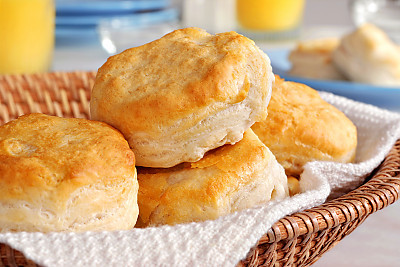







#ex: australia > victoria > bread#please rb so more people can see#american english#australian english#british english#canadian english#english#english language#dialects#accents#american accent#australian accent#british accent#canadian accent#english accent#america#australia#england#canada#those four are my target audience but all answers from around the world are welcome!!#tumblr#discourse#experiment#click the link for part one
584 notes
·
View notes